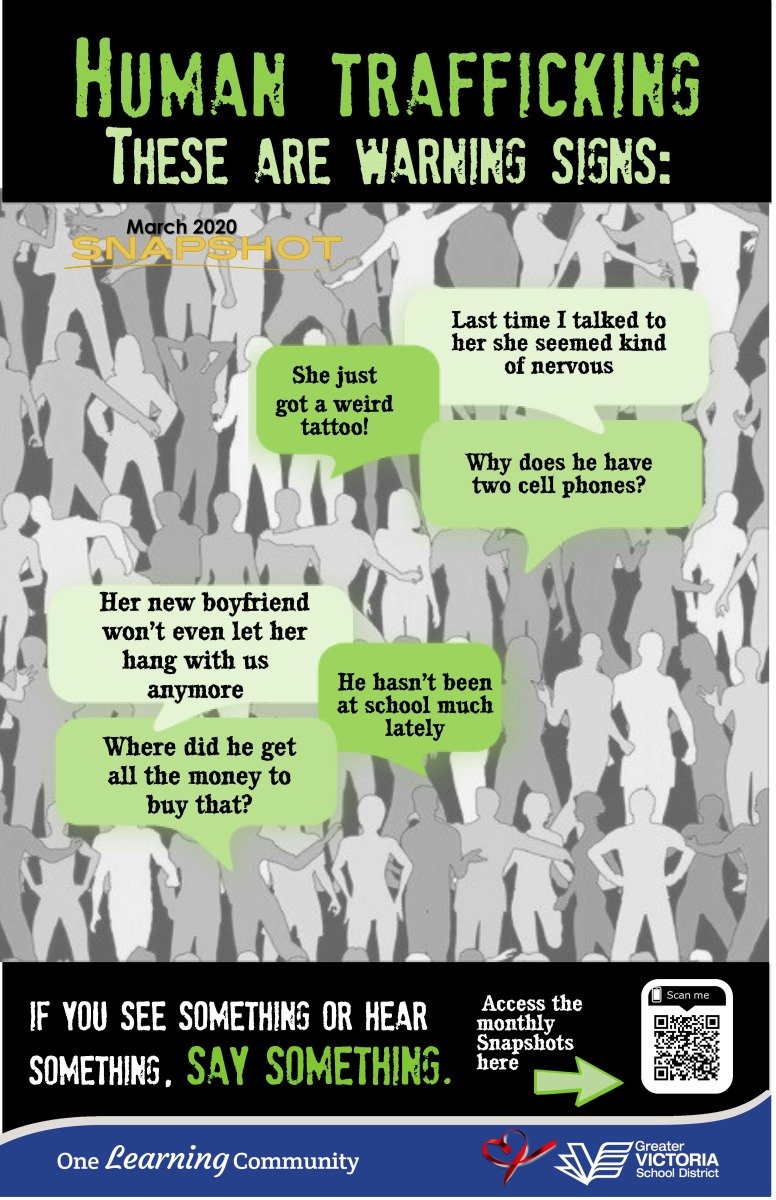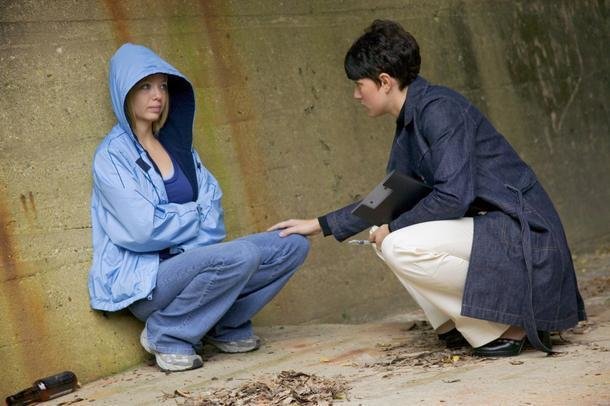|
|
|
| |
| |
| Human Trafficking March 2020 |
|
|
|
![Human Trafficking March 2020]() |
|
|
|
|
|
 | March 2020
Secondary Snapshot
Human Trafficking
|
|
|
|
|

| Human trafficking happens in almost every country around the world, and exists in our community as well. Traffickers represent every social, ethnic, and racial group. Various organizational types exist in trafficking, including large nationwide gangs and criminal organizations, local street gangs, and individuals with no affiliation with any one group or organization. Traffickers can be both men and women.
Increasingly, traffickers are using fear tactics to lure children and youth into commercial sex acts and/or forced labor. The goal of the trafficker is to exploit and enslave victims using coercive and deceptive practices.
|
|
|
| IN WHAT WAYS ARE YOUTH EXPLOITED?
|
|
|
|
Recruiting, enticing, harboring, transporting, providing, obtaining, and/or maintaining a minor for the purpose of commercial sexual exploitation
Exploiting a minor through prostitution
Exploiting a minor through survival sex (exchanging sex/sexual acts for money or something of value, such as shelter, food, or drugs)
Exploiting a minor through sex tourism
| Exploiting a minor by having her or him perform in sexual venues (e.g., peep shows, strip clubs)
Exploiting a minor through forced labor, including involuntary domestic service (e.g., nanny, maid)
Exploiting a minor through bonded labor or debt bondage
Exploiting a minor through forced child labor (e.g., sweatshop workers, janitors, restaurant workers, fishery workers, hotel and tourist industry workers, beggars)
|
| |
|
|
|
| WHAT FACTORS CAN MAKE YOUTH AT RISK FOR EXPLOITATION?
|
|
|
|
- lack of personal safety
- isolation
- emotional distress
- homelessness
- poverty
- family dysfunction
- substance abuse
| - mental illness
- learning disabilities
- developmental delay
- childhood sexual abuse
- promotion of sexual exploitation by family - members or peers
- lack of social support
|
| |
|
| WHAT TECHNIQUES DO TRAFFICKERS USE?
|
|
|
Young people, especially those with risk factors, are vulnerable to human trafficking These young people are often preyed on by traffickers and lured with false promises of love, money, or simply a better life. Traffickers may also use a variety of techniques to instill fear in victims and ensure that they remain under their control:
Physically restricting victims or restricting their freedom of movement
(e.g., keeping victims under lock and key or constant surveillance)
Using debt bondage
(e.g., imposing financial obligations, convincing victims they are honor-bound to satisfy debt)
|
|
|

| Isolating victims from the public
(e.g., limiting contact with outsiders, ensuring that contact is monitored or superficial)
Isolating victims from their family members and members of their ethnic and religious community
Confiscating victims‘ passports, visas, and identification documents
Using or threatening to use violence toward victims and their families
Threatening to shame victims by exposing their circumstances to their family
Telling victims that they will be imprisoned for crimes they were forced to commit or deported for immigration violations if they contact authorities
Controlling victims‘ money
(e.g., holding their money for “safekeeping”)
|
|
|

| Social workers who provide services to these victims indicate that feelings of isolation and abandonment are often reported but that the lack of a support network increases the vulnerability to trafficking
It is important to note that many teenage girls may be at risk of being recruited into the commercial sex industry simply by virtue of their normal maturation process. Wanting to take risks, feeling misunderstood by parents, and seeking romantic relationships can increase girls‘ susceptibility to the recruitment tactics of sex traffickers or pimps.
|
|
|
Findings also suggest that low self-esteem accompanies school failure for girls, and the resulting sense of a lack of self-worth may make them more vulnerable to recruitment.
However, once a student is victimized, identifying him or her can prove difficult for a variety of reasons:
- the student‘s reluctance to disclose the problem due to a sense of shame and fear;
- the stigma associated with forced prostitution;
- the power and control of the trafficker‘s seduction and manipulation;
- the student‘s inability to recognize that he or she is a victim and, therefore, is unwilling to seek help.
|
|
|
| INDICATORS THAT A YOUTH IS BEING TARGETED
|
|
|
an inability to attend school on a regular basis and/or unexplained absences
frequently running away from home
references made to frequent travel to other cities
bruises or other signs of physical trauma, withdrawn behavior, depression, anxiety, or fear
lack of control over a personal schedule and/or identification or travel documents
hunger, malnourishment, or inappropriate dress (based on weather conditions or surroundings)
signs of drug addiction
coached or rehearsed responses to questions
a sudden change in attire, behavior, relationships, or material possessions (e.g., expensive items)
uncharacteristic promiscuity and/or references to sexual situations or terminology beyond age-specific norms | a “boyfriend” or “girlfriend” who is noticeably older and/or controlling
an attempt to conceal scars, tattoos, or bruises
a sudden change in attention to personal hygiene
tattoos (a form of branding) displaying the name or moniker of a trafficker, such as “daddy”
hyperarousal or symptoms of anger, panic, phobia, irritability, hyperactivity, frequent crying, temper tantrums, regressive behavior, and/or clinging behavior
hypoarousal or symptoms of daydreaming, inability to bond with others, inattention, forgetfulness, and/or shyness
owing a large debt and being unable to pay it off
not being in control of his or her own money
|
|
|
|
|
|
|
|
|
|
|
|

| GENERAL HARM REDUCTION STRATEGIES
1. Avoid, Delay, Reduce Use
2. Don‘t Use Alone
3. Carry Naloxone, if around
Opioids:
Toward the Heart
|
| |
|
|
|
The Greater Victoria School District is committed to providing safe and healthy learning environments for all students. As part of our approach, we have been focusing on mental health and substance use topics to help us promote well-being in our schools.
Substance use is a complex topic that often highlights varied philosophies, myths, and a great deal of fear.
|
The research shows us that early interventions, particularly around critical thinking and decision making, has an impact on delaying use in youth. As well, open dialogue with adults, intentionality around attachment, and a focus on the factors that contribute to substance use, as opposed to the actual substances, also prevent, delay and reduce substance use in our students.
|
Our goal is to create a more cohesive, systematized substance use plan focusing on social emotional learning, that includes our youth and schools, community partners, and families. We strive for a shared vision, common language and consistent messaging over time, in order to support positive youth culture and a healthy perspective on substance use and mental health.
|
|
|
|
|
| |
|
|
|
|
|
|
|
|
| |
|